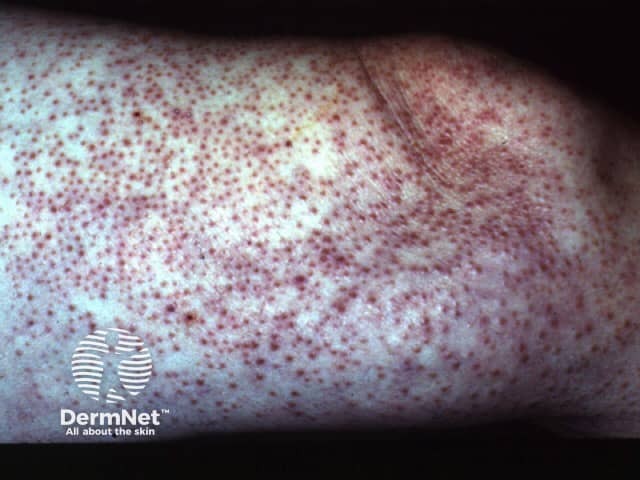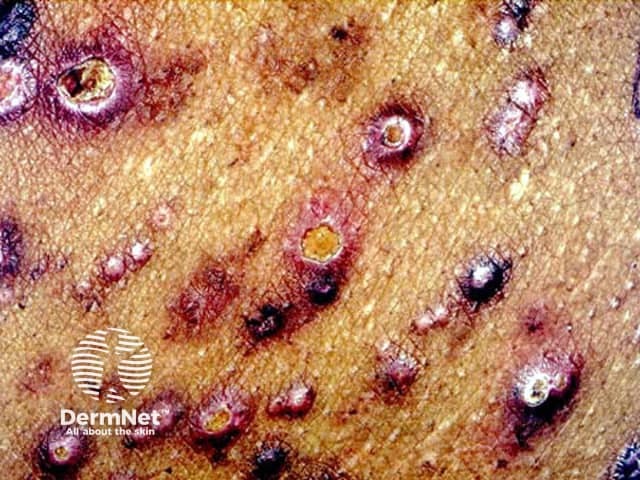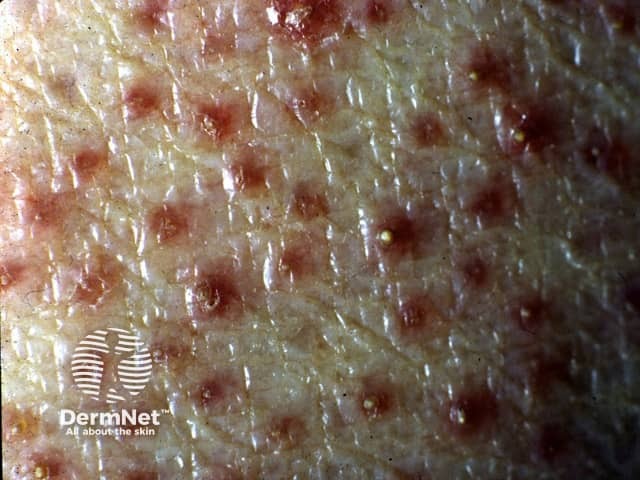Main menu
Common skin conditions

NEWS
Join DermNet PRO
Read more
Quick links
Kyrle disease — extra information
Kyrle disease
Authors: Vanessa Ngan, Staff Writer, 2005; Updated: Dr Aswan Tai, Peter MacCallum Cancer Centre, Melbourne, Australia; Dr Sarah Smithson, Dermatologist, Skin Health Institute, Melbourne, Australia. Copy edited by Gus Mitchell. April 2022
Introduction Demographics Causes Clinical features Complications Diagnosis Differential diagnoses Treatment Outcome
What is Kyrle disease?
Kyrle disease is characterised by transepidermal elimination of keratin from the dermis through the epidermis onto the skin surface. It is a subtype of primary perforating dermatosis along with reactive perforating collagenosis, perforating folliculitis, and elastosis perforans serpiginosa.
Kyrle disease was first described in 1916 by Austrian dermatologist and pathologist Josef Kyrle as “hyperkeratosis follicularis et parafollicularis in cutem penetrams” in a diabetic female patient with generalised hyperkeratotic papules.
There is longstanding controversy surrounding the classification of Kyrle disease, with some clinicians believing it to be a distinct clinical entity and others considering it as within the reactive perforating collagenosis spectrum.



Who gets Kyrle disease?
- Can affect both males and females throughout life.
- Onset is usually in adulthood around 30 years of age.
- No clear racial predilection.
- Strong association with diabetes mellitus, chronic renal disease, chronic liver diseases, and congestive heart failure.
What causes Kyrle disease?
The pathogenesis of Kyrle disease (KD) is unclear.
- The keratinization process in KD is altered, occurring at the basal layer in the epidermis.
- Abnormal keratin elicits a host inflammatory response higher in the epidermis.
- Keratin and other materials are eliminated through the epidermis.
- The presence of altered or abnormal connective tissue may be a predisposing factor in KD.
- Immune dysregulation in chronic renal failure may contribute to the development of KD through increased expression of interleukin (IL)-31, a predominately T-cell-derived cytokine strongly correlated with itch provocation.
What are the clinical features of Kyrle disease?
Kyrle disease is a papulonodular mucocutaneous disorder.
- Red-brown papules and nodules with silvery scales, commonly with central keratin (horny) plug.
- Lesions vary in shape and size and can grow up to 1.5cm in diameter.
- Lesions are not normally painful or tender but can be intensely itchy.
- Commonly exhibits the Koebner phenomenon.
- Mostly located on the extensor surface of lower limbs but can also develop on the arms as well as head and neck region. Rarely on the palms, soles, and mucous membrane.
- Associated with hyperpigmentation in skin of colour.
- Lesions can heal spontaneously without treatment, however new lesions may continue to develop.
What are the complications of Kyrle disease?
- Impact of chronic intense itch on quality of life.
- Secondary bacterial and fungal infections from impaired skin barrier and scratching.
- Healing of individual lesions with scarring and/or dyspigmentation in all skin types.
How is Kyrle disease diagnosed?
Kyrle disease can usually be diagnosed on its distinct clinical features, associated conditions, and confirmed on skin biopsy with histopathology showing incomplete keratinisation and a hyperkeratotic, parakeratotic plug.
What is the differential diagnosis for Kyrle disease?
- Other primary perforating dermatoses — reactive perforating collagenosis, elastosis perforans serpiginosa, and perforating folliculitis
- Flegel disease (lesions are similar but smaller and more common on the feet and lower legs)
- Secondary perforating disorders including granuloma annulare, lichen nitidus, chromoblastomycosis
- Prurigo nodularis
- Keratoacanthoma
- Folliculitis.
What is the treatment for Kyrle disease?
The main aim of treatment is to control itch and avoid superficial trauma. Rapid improvement and resolution of lesions are often seen once any associated underlying disease is managed.
- Topical — emollients, topical steroids, topical retinoids, keratolytic agents
- Systemic — antihistamines, oral antibiotics (tetracycline agents), oral retinoids, allopurinol, tacrolimus
- Other — phototherapy
- Clinical trial — immunomodulatory drugs (eg, IL-31 monoclonal antibodies such as nemolizumab).
What is the outcome for Kyrle disease?
Lesions are self-healing but often recur. Individuals can develop larger and more lesions with age.
References
- Ataseven A, Ozturk P, Kucukosmanoglu I, Kurtipek GS. Kyrle's disease. BMJ Case Rep. 2014;2014:bcr2013009905. Published 2014 Jan 15. doi:10.1136/bcr-2013-009905. PubMed
- Bodman M, Ehredt D Jr, Barker R, Kirkland A, Mude P. Kyrle Disease A Rare Dermatologic Condition Associated with the Diabetic Foot. J Am Podiatr Med Assoc. 2015;105(5):451-455. doi:10.7547/14-009. PubMed
- Forouzandeh M, Stratman S, Yosipovitch G. The treatment of Kyrle's disease: a systematic review. J Eur Acad Dermatol Venereol. 2020;34(7):1457–63. doi:10.1111/jdv.16182. Journal
- Rapini RP, Herbert AA, Drucker CR. Acquired perforating dermatosis. Evidence for combined transepidermal elimination of both collagen and elastic fibers. Arch Dermatol. 1989;125(8):1074–8. doi:10.1001/archderm.125.8.1074. Journal
- Rice AS, Zedek D. Kyrle Disease. In: StatPearls. Treasure Island (FL): StatPearls Publishing; June 4, 2021. Book
On DermNet
- Reactive perforating collagenosis
- Flegel disease
- Pruritus
- Skin problems associated with diabetes mellitus
Other websites
- Kyrle Disease — Medscape Reference
- Kyrle Disease — NIH Genetic and Rare Diseases Information Center
